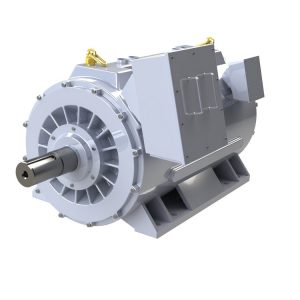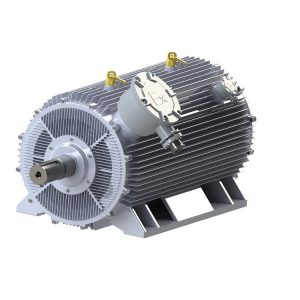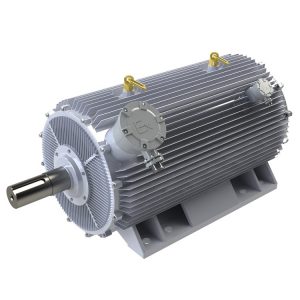Permanent magnet synchronous machines are AC motors that operate at a constant speed, synchronized with the frequency of the AC supply current. As a fact, one of the peculiar features is constancy of speed, since the rotational speed of the motor is directly proportional to the frequency of the electrical supply. Synchronous motors are specially recognized for running at a constant speed without variation with load and thus find applications in areas where precision and consistency are indispensable.



The major components in a PMSM motor include the stator, rotor, and exciter. The stator produces a rotating magnetic field with an AC supplied to it, while the rotor is composed of electromagnets or permanent magnets interacting with this rotating magnetic field. The exciter supplies the DC to the rotor. These parts interact in such a way that the rotor will always keep up with, or stay in sync with, the stator’s magnetic field, hence the constant speed typical for synchronous motors.
The synchronous motors have wide applications in places where exact and constant speed is called for. Common applications include clocks, record players, and synchronous timers. In industrial applications, they are found in processes that require speed control and timing, such as conveyor systems, robotics, and large-scale manufacturing equipment. Furthermore, these magnet motors are useful in power factor correction, hence increasing the efficiency of power systems at big electrical grids.
As one of the famous manufacturers of permanent magnet motors, Qingdao Enneng Motor Co., Ltd. is a high-tech enterprise integrating R & D and manufacturing of permanent magnet motors. With more than dozens of patents, Enneng has ranked as “100 Innovative Enterprises” in Qingdao and we have been selected as a member of the Qingdao Motor Association.
Asynchronous motors, also widely known as induction motors, are based on the principle of electromagnetic induction. Unlike synchronous motors, their speed depends on the load and is not synchronized with the frequency of the supply current. The slip between the rotational speed of the rotor and the stator’s rotating magnetic field generates the required torque to drive the motor. This slip is thus necessary for the motor to work and is the distinguishing feature of the motor from synchronous ones.
The major components of a battery magnet motor include the stator, rotor, and slip rings if it’s of the wound-rotor set. The stator contains windings that produce a rotating magnetic field when fed with an AC. The rotor, normally a squirrel cage type or wound type, is located inside the stator. In squirrel-cage motors, the rotor is made up of aluminum or copper bars, which are short-circuited at both ends and embedded in the steel core. This kind of construction is very crucial to inducing current for producing torque in the rotor.
Induction AC motors are applied for many industrial purposes, starting with manufacturing and HVAC, water pumping, conveyor systems, and so on. Their robust and reliable nature makes them suitable for continuous-duty applications.
The major difference in operation between synchronous and asynchronous motors is their speed. AC synchronous permanent magnet electric motors operate at a constant speed and are equal to the supply frequency, thus providing accuracy for operations that depend on exact timing. Asynchronous motors, however, depend on the heavier the load, the slower the motor operates- and allow variability in applications that require a range in speed. With this variability, asynchronous motors can also operate under conditions of fluctuating loads.
PMSM machines require an AC and a DC power supply in their operation. AC supplies power to stator windings to produce a rotating magnetic field, while the DC power is fed onto the rotor for synchronization at all instances. On the other side, asynchronous motors require only an AC supply for their work. The magnetic field generated by the stator induces a current on the rotor due to electromagnetic induction, and hence it does not require any extra DC feed.
Another critical difference between the two types of motors is efficiency. Synchronous motors are said to be very efficient because it does not incur losses by slipping. Their high power factor and the ability to operate at an exact speed make synchronous motors fit for applications where energy efficiency is of prime essence. Asynchronous motors, on the other hand, are normally efficient but are subject to slip hence leading to energy losses. Nevertheless, the ruggedness of their design and the capability to operate under variable loads make them attractive in several practical applications.
The rotor in synchronous and asynchronous motors is designed very differently. The rotor of synchronous motors may be either salient pole or cylindrical type, each containing either an electromagnet energized by DC or permanent magnets. This kind of design is critical for the motor to maintain synchronization with the stator’s magnetic field. Asynchronous motors generally employ either a squirrel-cage rotor or a wound rotor. In the former, there are aluminum or copper bars that are short-circuited at both ends to form a metallic ‘cage’, and this cage produces torque when it is under the influence of the magnetic field of the stator. The latter contains windings that are connected through slip rings, thereby allowing variations in external resistance and increased torque.
Stator design also differs between synchronous and asynchronous motors. The stator in synchronous motors is designed to provide a rotating magnetic field by inducing an alternating current through its windings. For the rotor to remain in step, the magnetic field generated by the stator should be stable and precisely balanced. In asynchronous motors, the stator similarly provides the function of generating a rotating magnetic field but is optimized to induce current within the rotor. The design focuses on efficiency and strength in performance during load variations. These differences in stator design contribute to the varied operational characteristics of these motor types.
The major advantage of synchronous motors is their high efficiency. Synchronous motors have no slip; hence, no losses are associated with this phenomenon. This no slip in synchronous motors means that they can boast impressive energy efficiency, translating to lower operation costs and reduced energy consumption over time. High efficiency therefore makes them ideal for use in applications where energy savings are crucial and operational costs must be minimized.
Another merit of synchronous motors is the correction of the power factor. Such motors will improve the power factor in an electrical system, hence improving the efficiency of the power distribution network. The synchronous motor can run in a leading power factor mode of operation and hence may compensate for the lagging power factors brought about by other inductive loads. This capability is of utmost importance in huge industrial and manufacturing setups where power quality management is of vital importance.
Insist on the research and development of a series of special high & low voltage Low-speed High-torque permanent magnet motors, ENNENG, and special direct-drive permanent magnet motors. The ENNENG permanent magnet motor is widely used in China. Many top companies from mining gold, coal, and tires to drilling oil, and treating water to save energy as well as protect the environment.
Induction motors or asynchronous motors have an extremely simple design that provides them with strength and reliability. Without an exciter, and relying on an AC power supply alone, fewer components could fail. This simplicity reduces not only the cost of the motor manufacturing process but also the chances of operational problems. Their straightforward design results in lower initial costs and easier maintenance, hence their high popularity in many industries.
Another major benefit associated with asynchronous motors is that they are cost-effective. They have a generally cheaper production cost compared to synchronous motors and, therefore, prove economical for many purposes. This is also made possible by the fact that they support variable loads well without requiring complicated control systems. Their low maintenance requirement, coupled with a long time of useful operation, provides a favorable economic basis in small as well as vast installations.
ENNENG follows the quality concept of “Precision Performance “, introduces advanced product design and manufacturing processes at home and abroad, and provides products that meet national and international quality standards.
Because of their characteristics, synchronous and asynchronous motors find their applications in a wide range of industries. Synchronous motors find great applications in robotics, conveyor belts, and electric power generation plants where exacting control over speed is desired. In general, applications that need highly efficient drives and improvement of the power factor-especially those with widespread electrical distribution systems always opt for synchronous motors. Asynchronous motors are generally adopted for fans, refrigerators, and all home-based applications because of their mechanical hardness and economy. They find industrial applications in pumps, compressors, and other such equipment where high starting torque and variable speed are required. Such knowledge of general applications assists in the selection of the right motor type according to needs.
Selection between a synchronous motor and an asynchronous motor involves basing several factors on application-specific requirements, efficiency, cost, and maintenance needs. While more expensive to buy, permanent magnet synchronous electric motors are generally the better choice for applications that require precision speed control and high efficiency. In applications requiring strong performance at variable loads and where a limited budget is available, direct current permanent magnet motors are an advantageous compromise, considering cost-effectiveness and reliability. Evaluating these factors carefully ensures a considered decision that is aligned with operational goals and budgetary considerations.